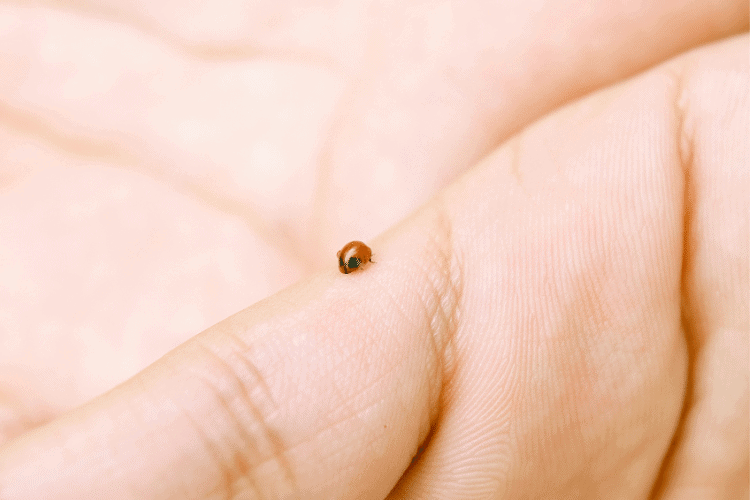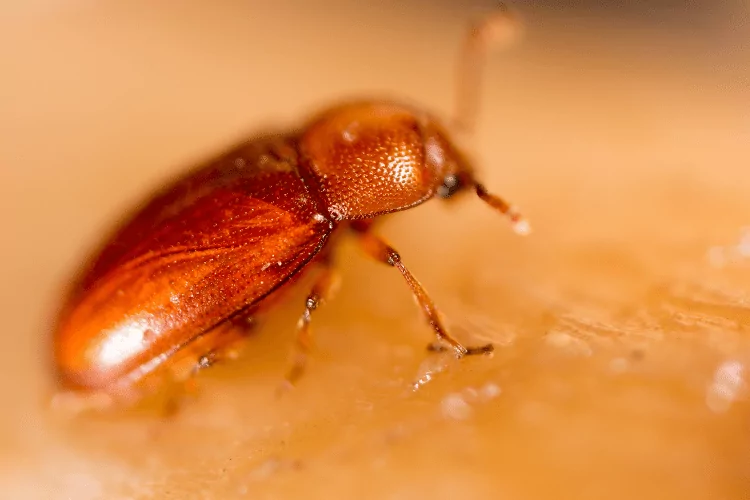One of the most destructive beekeeping pests, small hive beetles damage honey, pollen, comb, and bee larvae.
Small hive beetles can result in massive losses for the beekeeper as they feed on/ferment the honey, eat honey brood, decrease the conductivity of your honey bees, weaken the colony, and eventually cause stressed bees to swarm away from the hive.
Learning how to deal with small hive beetles is a must for beekeepers to prevent the failure of their hive in case of an invasion. Luckily, there are many ways to kill and repel these problematic pests.
From dryer sheets for small hive beetles to permethrin, freezing, wintergreen oil, and nematode worms, today’s guide offers plenty of methods to help your beehive fight the infestation.
How Do Dryer Sheets Get Rid of Small Hive Beetles?
Dryer sheets are meant for use in laundry. Each sheet consists of a layer of fabric made of cellulose fibers or polyester, coated in liquid softeners, lubricants, and sometimes fragrances.
These sheets are supposed to reduce static and make clothes softer with a nice smell. However, they have various alternative uses such as removing dust and soaking up greasy/oily spills.
In the beekeeping world, dry sheets can help reduce the population of small hive beetles in a bee colony.
Although honeybees can’t kill small hive beetles with their stingers due to the pests’ hard shells, bees in the hive chase small hive beetles and force them to gather in corners. From there, guard bees keep the insects from escaping and spreading throughout the colony.
The effect of dryer sheets against small hive beetles shows when you place dryer sheets into the corners and areas where bees round up the pests. Once the unwelcome guests come in contact with the dryer sheets, they get tangled up and stuck.

With the small hive beetles now caught and unable to leave, they’ll starve to death and lose the possibility of laying eggs around the beehive. The result is a rapid decline in the scale of the small hive beetle infestation.
The repeated use of dryer sheets over a long-enough period will successfully rid your apiary of all the small hive beetles trespassing.
Pros
- Dryer sheets are highly effective
- You can find dryer sheets readily in stores
- Dryer sheets are available in many brands at varying price points
- Dryer sheets don’t take too long to produce results
- Unlike chemicals, small hive beetles can’t develop resistance to dryer sheets so you can use this method as many times as needed
Cons
There’s a chance of a few bees also getting stuck in the dryer sheets along with the small hive beetles.
Still, most beekeepers view it as a worthy sacrifice to win the war against the pesky critters.
You can curb the incidence of friendly fires by placing a screen mesh over the dryer sheets. This makes it harder for the bees to reach the sheet and get trapped.
How to Use Dryer Sheets for Small Hive Beetle
First things first, make sure you’re using dry and odor-free dryer sheets as fragrances can harm the honeybees. Once you have your dryer sheets on hand, follow the steps below:
- Cut the dryer sheets into 4 x 4-inch squares or strips.
- Place the dryer sheet pieces inside the beehive; on top of the frames under the lid and in the cover.
- Wait a few days before checking the dryer sheet pieces. You should find a lot of dead beetles stuck on them.
- Dispose of the used sheets and place fresh ones if needed.
Other Ways to Get Rid of Small Hive Beetles
Besides dryer sheets for small hive beetle, here are alternative common ways to combat these pests:
Traps
The concept of trapping the small hive beetles isn’t a feature of dryer sheets only. There are multiple other types of traps you can use in your apiary, including:
Beetle Blaster
Designed by beekeeping expert Laurence Cutts, the Beetle Blaster is a disposable hive beetle trap that you hang between the frames in the beehive, particularly the top bars.
It’s made of bee-safe plastic and features compartments to house a small amount of oil (mineral or vegetable). After pouring in the oil, be sure to wipe off any oil from the top of the trap before parking it inside the hive.
The oil makes the trap walls slick, so the hive beetles can’t get a hold. The pests also get covered in oil, which eventually suffocates them.
The Beetle Buster isn’t reusable but it’s pretty affordable.
CD Cases
If you still have some old slim-style CD cases sitting in storage, you can whip them into traps for small hive beetles.
Start by trimming the sides of the plastic CD case and its cover using pliers to create multiple entrances for the hive beetles.
Using a slim-style case is crucial to ensure that the points of entry are small enough to let the beetles in while preventing the bees from crawling inside as well.
From there, you just need to spread some bait on the inside of the case to lure in and kill the hive beetles.
How to Make Bait
While commercial options are available, You can make bait at home and add it to traps to lure in small hive beetles and get rid of them. Here are a couple of the most effective recipes:
Recipe #1
Not only will this recipe hold the small hive beetles captive, but it’ll also kill them after they feed on it. Mix the following ingredients to create a paste:
- 1 teaspoon of honey
- 1 teaspoon of boric acid
- 1 tablespoon of vegetable shortening
Recipe #2
This recipe is highly effective in attracting small hive beetles into traps. Mix the following ingredients to create a paste:
- 1 cup of water
- 1/4 cup of sugar
- 1/2 cup of apple cider vinegar
- The chopped bits of the peel of 1 ripe banana
Let the concoction sit for a couple of days to ferment and then sieve out the chopped bits of the banana peel. You can now use this bait in your traps.
Essential Oils
Wintergreen oil and other types of essential oils can help control small hive beetles, varroa mites, and tracheal mites.
You can add wintergreen oil to traps to hinder the movement of small hive beetles and suffocate them. You can also soak a cardboard coaster in the oil and place it in brood boxes, or dab it directly onto the corners of the boxes and the frames.
To prepare wintergreen oil for use in beehives, mix 1 ounce of wintergreen essential oil with 16 ounces of vegetable shortening.
Chemicals
You can use pesticides to get rid of small hive beetles but be mindful of how much you use and for how long. Pay attention to the application instructions as bees can also get affected by the chemicals.

Boric Acid
A mixture of boric acid and essential oil such as wintergreen oil can be effective in killing small hive beetles.
Apply boric acid mixed to the inside of a cutout piece of Correx board and dab its edges in vegetable shortening. When the hive beetles feed through the shortening, they’ll reach the boric acid and die.
Coumaphos
Effective against small hive beetles and varroa mites, the application of coumaphos takes around 45 days to complete successfully.
Don’t use this chemical when harvesting honey from the affected beehive. Also, wear chemical-resistant gloves when handling coumaphos strips, not leather bee gloves as they won’t provide adequate protection and may harm the bees upon contact with their hive later on.
How to Get Rid of Small Hive Beetle Larvae
Light
Place a light source near the entrance or floor of the beehive to draw out small hive beetle larvae. You can then scope them up and drown them in soapy water.
Freezing
You can freeze the infested frames to kill the small hive beetle larvae. Simply pop them out of the beehive(s) and place them in a freezer for at least 4 days.
After that, take out the frames and wash off the dead larvae.
Chickens
Seeking the aid of chickens is another method to get rid of small hive beetle larvae. All you need to do is hang the infested frames in a chicken coup.
The chickens will eat up the larvae when they fall to the ground, killing their chances of developing into the next life stage (pupa).
Diatomaceous Earth
Sprinkling diatomaceous earth on the ground around beehives can protect them from small hive beetle infestations as it kills larvae and pupa in the soil.
Wrapping Up
Using dryer sheets for small hive beetle infestation is a practical, affordable, and easy-to-apply method of clearing out these tiny pests. It’s highly effective, doesn’t harm the bees, doesn’t take long to show results, and is immune to the hive beetles developing resistance.
Alternatively, you can use traps, bait, chemicals, and essential oils to get rid of hive beetles. Light, freezing, diatomaceous earth, and chickens can help control hive beetle larvae.
- Does Bleach Kill Bees? - April 23, 2024
- How Do I Get Rid of Ants Without Harming Bees? - April 16, 2024
- Do Bug Zappers Kill Bees? Completely Explained - April 9, 2024
